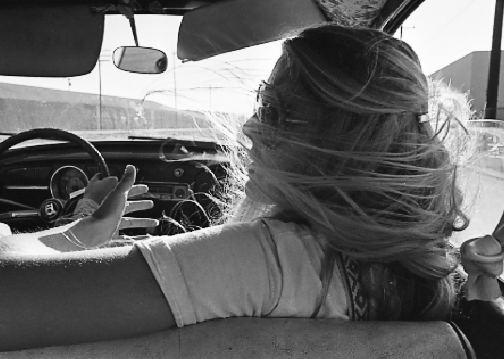P.O.P
Pacific Ocean Park

ベニスビーチは、スケートボードの発祥の地でもある。もちろん、それ以前からサーフィンはあった。カリフォルニアの他のポイントと同様、ベニスビーチのサーファーたちも、P.O.Pの橋桁を縫うようにライディングしていた。
1965年。東京。カメラマンのアシスタントになって、あっという間に3年が経っていた僕は、早く旅に出なくちゃ、と何かがいつも僕の中でせっついていた。そんな時、本屋で出会った一冊の本「聖なる野蛮人(THE HOLLY BARBARIANS)」。そこに描かれていたのが、ベニス・ウェストの町だった。
その町は、1900年代はじめにアボット・キニーという夢想家が、イタリアの水の都ベニスを再現しようと作った奇妙な生い立ちの町で、キニーは運河を掘り、橋を築き、コロナードを造り、ご丁寧にもゴンドラと船頭まで連れてきたそうだ。ビーチ沿いにはアミューズメントパークやホテル。だが美しい南カリフォルニアの観光地として賑わったベニスビーチも、1925年にロサンゼルス市に合併された頃から廃れていく。鉄道が敷かれ、石油の採掘が始まったためだ。運河は埋め立てられ、物資や石油の輸送路に変わっていった。あっという間に町は姿を変えた。
20数年の後、石油は干上がった。残されたのは経済至上主義に好き勝手に翻弄されたベニスビーチだった。わずかに生き残っていた運河は石油にまみれ、ホテルは荒れ放題に荒れて、かつての華やかな面影はどこにもなくなった。ジャンキーとボヘミアン、わずかな年金を頼りの老人、ヒッチハイカー。アーティスト、ミュージシャン、詩人、宗教家。好奇心を膨らませ、刺激を求めてやってくる中産階級の白人たち、功名心に駆られたマスコミ関係者たちが新しい町の住人となった。
こんな町に、僕は惹かれた。グリニッジビレッジでもサンフランシスコでもなくベニス。危なそうだけれど、でもおそらくとても自由な町だろうと思った。そこで暮らすことが、本物のビートニックになる道だと思った。1969年の夏、僕はベニス・ウェストを目指して旅に出た。
たどり着いた場所に、想像していた世界はまるで広がっていなかった。ビートニックなんて全然いなかった。憧れのウェストコーストジャズも、もう廃れていた。時代はロックで、いたのはロングヘアのヒッピーたち。世の中、変わっちゃったんだ。大ショックだった。想像以上に汚れた町。それでも危なさやなんとも言えない開放感は、想像通りだった。僕は、これはこれでいいなぁ、と思った。
安アパートを借りて、僕はベニスビーチのスピードウェイに暮らしはじめた。見る間にベニスに染まっていった。空気に、色に、匂いに、ドラッグに。歩き方まで変わった。写真も撮りまくった。一日最低でもトライX一本をノルマにして、夜は部屋でその日撮ったフィルムを現像した。こうして1969年から1972年まで、僕はベニスに住んだ。ビザの関係で数回は日本に帰っても、すぐにまた舞い戻った。
この町の何もかもが心に響いた。バシャバシャ撮った。その写真は本当にリラックスした状態で撮ったスナップで、被写体になってくれた人たちもまた、僕と同じ状態にある写真だ。アメリカ中を旅しようと買ったV.Wキャンパーでトパンガキャニオンに出かけて行くと、帰りは必ずマリブビーチに寄って、夕日が落ちるまで何時間もボーっとサーファーたちのライディングを眺めているのが好きだった。
P.O.P- Pacific Ocean Park。
Pierは、かつての栄光も後の荒廃も、その体全部で受け止めて、着飾り、剥ぎ取られ、傷つき、朽ちていったベニスの良き時代の象徴とも言える桟橋のことだ。僕にとっては常にフォトジェニックな存在であり続けたけれど、今はもう取り壊されてしまった。
でもP.O.Pはベニスビーチに暮らした時間と一緒に、僕の心の中にある。僕の旅の続きが路上から波の上へと場所を移した今も、それは不思議なほど、ずっと朽ちずにある。
小林 昭
Venice Beach is known for being the pioneering district among skateboarders. Of course surfing was there before that and like many other points of California, surfers were riding the waves winding their way in and out of the bridge girders of P.O.P.
In 1965, three years had quickly passed while working as an assistant for a photographer in Tokyo. Something kept on buzzing inside me telling me that I should hurry out to go on a trip. It was then, I found a book in a bookstore,“The Holly Barbarians.” In it was written about the town of Venice West.
The town, founded by Utopian dreamer, Abbot Kinney in the early 1900s,had a strange birth story since his idea was to reproduce Venice, the city of canals in Italy. Kinney cut canals, built bridges, made colonnades. He had even brought in gondolas and gondoliers for it to be complete. There were amusement parks and hotels by the beach. But Venice Beach which became a beautiful sightseeing spot in Southern California, was to lose popularity and tarnish when the place was anneyed to the city of Los Angeles in 1925.Railroads were laid for drilling the oil. Canals were filled in to be used as transportation passages for oil and supplies. The town changed in no time.
Twenty years later, the oil dried up. What remained was Venice Beach, a town that was carelessly treated by the economy for the sake of it. The few canals that had survived were covered with oil, the hotels were in their worst state, leaving no trace of their flamboyant days. Instead, there were junkies and bohemians, old men on small pension and hitchhikers,artists,musicians, poets and men of religion. White men who came out of curiosity and in search of more excitement gathered as did media-related people wanting to gain fame. They were the new residents of the town.
This town became my attraction. It wasn’t Greenwich Village nor San Francisco but Venice. I assumed the town to be dangerous but free. To live there seemed to be the way to become a true beatnik. In the summer of 1969, I left for Venice West.
When I got there, I couldn’t find anything I had anticipated. Not one beatnik. The West Coast jazz I adored had also finished. The age was rock and there were the hippies with long hair. The world had changed. I was blown away by the shock. The town was much filthier than I had imagined it to be yet there was this amazing sense of freedom I had longed for. “This I guess is OK,too.” I thought.
I rented a shabby apartment and started to live on Speedway in Venice Beach. Very quickly, I became absorbed by the town. By the air, the color, the smell, the drugs. Even the way I walked had changed. I took one picture after another. I had decided on taking at least one roll of TRY-X a day and at night I would develop the film in my room. And so from 1969 to 1972, I lived in Venice. Even when I had to return to Japan a few times for visa reasons. I would dash back to the town.
Everything about the town thrilled me and I was obsessed by talking photographs. Those snapshots were taken in a truly relaxed state. The people I took pictures of were also as relaxed as I was. Later, I bought myself a V.W. Camper to travel all around the U.S. and there were times I drove out to Topanga Canyon. On my return, I would always stop at Malibu Beach where I loved to stay until the sun set and watch surfers make their rides.
P.O.P. — Pacific Ocean Park. The Pier stood there accepting both the glories and the decay that followed as if it were there as a symbol of the good dans of Venice, once so lavishly dressed up then ruined and dismantled till it became a wreck. The Pier had always been a photogenic thing for me but it’s long been torn down now. Yet P.O.P. together with the days I sent in Venice Beach has staved in my heart. I keep hold of every bit of them unchanged knowing my quest still continues. My feet not on the ground but on the wave this time.
Akira Kobayashi
Photo Book ”P.O.P”

